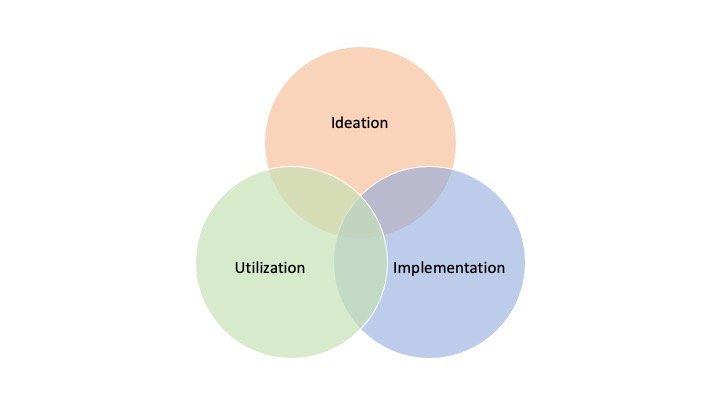Fifth, Make Places Resilient Through Reinvention and Reiteration
Understand Complex, Ill-defined Problems
Most theories of problem-solving oversimplify effective methodologies by isolating three tasks — (1) analyze the situation, (2) propose solutions, (3) evaluate the outcomes and pick the best. While each step in this process is essential, they are not independent. It is the reiteration, overlap and integration of these tasks that actually yields meaningful solutions. Each time we reiterate any of the key tasks (synthesizing solutions, evaluating outcomes, analyzing the problem) we will discover something new that was overlooked previously and needs to be reiterated within the other tasks.
The following diagram shows three sets of actions that must be reiterated to make places more resilient. Planners need to go back and forth in multiple directions, dozens of times to reach a successful conclusion. For those who insist on beginning with “analysis,” note that all three of these action steps include analysis, synthesis, and evaluation. Often the most productive way to start the process is with “ideation” where planners imagine a future state that seems better than the current conditions. Put another way, this diagram of a process has no “best” starting point. The key is reiteration of the process until we reach a point, close to the center, where further reiteration seems unwise.
To the left is a Venn diagram of the three interdependent problem-solving actions that planners must internalize. These actions, elaborated below, must be reiterated multiple times and in different sequences.
Ideation
Usually, one person offers an idea to build a building, make a new place, or change an existing place. The motivation can range from addressing a critical social problem to individual self-expression. Not all ideational actions identify a concept that will improve community resilience. Concept(s) may take form as drawings, text, trial constructions and so forth — but they are still just concepts. Each version of a concept leads to new ideas and new options. Valuable concepts may range from developing a new neighborhood to planting a few trees. Early discussions represent excellent opportunities for planners to insert ways to make a place or building more resilient.
Park East Freeway Redevelopment – “Ideation” required broad city-wide communication, collaborative design talent, and construction of a large scale physical model (clockwise from upper left: model construction, moveable development “concepts”, elected officials participating in the dialogue, and major public exhibition of potential outcomes). Milwaukee, 2003
Implementation
Effective conceptualization resonates with effective implementation. Do we have enough money for a specific idea? Is it legal? What are the political risks and rewards? How long will it take? Answers to these questions lead to changing a concept. For planners, a key issue always concerns feasibility. A new park may be desirable, but the community cannot afford to maintain it. A new building may be appealing but potential occupants show no demand for an increased supply of floor space. A new plaza may seem beautiful, but no one wants to use it. All of these risks (or rewards), once acknowledged, should lead to immediate concept changes. In short, the ability to implement a concept goes hand in hand with the sustainability and resilience of the concept.
Park East Freeway Redevelopment - “Implementation” required complex plans and detailed engineering decisions. Milwaukee, 2003
Utilization
Once implemented, the process of resilience does not end. Users of a new place will make modifications. Changes begin immediately. A building or place, once born, continues for decades if not centuries. As a community occupies a building, that place will start to change. Different individuals and organizations begin the maintenance and operation of a place including property owners, public service organizations, and the occupants. Often divergent needs and observations arise between those who (a) design and build a place and those who (b) operate and manage a place. In part, this divergence of needs comes from the financial separation of capital budgets and operating budgets and from the responsibilities exercised by both public and private sectors.
Park East Freeway Redevelopment - “Utilization” began immediately with the creation of the first apartment structure (above) in the newly planned development corridor. When the plan was approved, the absorption of new development was estimated at 20+ years. Such absorption actually occurred much faster in 15 years (even with the slowdown of the Great Recession). Moreover, secondary impacts of the project have spread to other surrounding neighborhoods, corridors, and districts with projects such as the mixed use riverfront structure (shown below). Milwaukee, 2007-2023.
Reiterate All Three Problem-Solving Activities
At the beginning of problem-solving, planners must reiterate ideation, implementation and utilization until all three become integrated in one set of solutions. The process of considering all three factors at the outset requires talent and patience. When these three types of actions are not given sufficient consideration, they will not “overlap”. If these three problem-solving tasks remain unresolved they usually create unsustainable places — the idea does not work, some aspect of the solutions is not feasible, and/or the place is not utilized as intended. Demolition, deconstruction, or excessive renovation may soon follow. In contrast, when planned effectively, future repair, renovation, or reconstruction of a place will improve long-term resilience.
Topic Summary
Understand Complex, Ill-defined Problems
Ideation
Implementation
Utilization
Reiterate All Three Problem-Solving Activities







